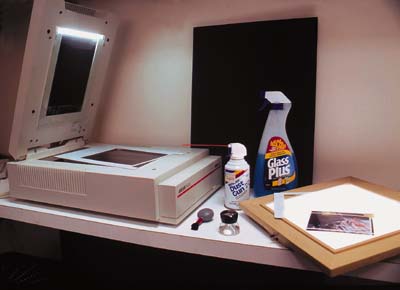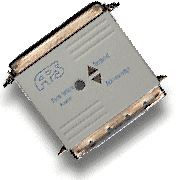

 |
 |
| Installing a scanner is usually quite easy. For the most part it's plug and play. That is, you plug in your scanner into your computer, install the scanner software, and play! But there can be a few "gotchas" along the way. | |
Basic Tools: A can of compressed air, glass cleaner, lens brush, black paper, spare scanner bulb, screw drivers, and black paper masks for 2 1/4" and 4" x 5" transparencies and negatives |
 |
 |
Some scanners have proprietary interface cards - these should be avoided, if possible, unless you: A) are getting an incredible deal; B) prefer that particular kind of interface; or C) get masochistic pleasure from fiddling with your computer and any incompatibilities that may ensue. A better alternative is to choose a scanner with a SCSI interface. The big advantage to SCSI is that you can easily add on a variety of different kinds of devices: everything from CD ROM drives to removable hard disks, tape drives, modems and of course, other scanners. Most current scanners are available in SCSI versions, and for good reason. SCSI is an open, fast and generally reliable technology. However, many scanner communication problems are caused by borderline SCSI subsystems. You may have a borderline SCSI system if you have experienced any of the following: Scans that fail to finish, slow performance, "can't find scanner" warnings or mysterious program crashes and errors. Even hard disk crashes can be traced to failures or conflicts somewhere in the SCSI chain. Some people never have SCSI problems and can't understand what all the fuss is about. Others curse their computers daily and wonder what they did wrong in a previous life. For PC users a SCSI driver needs to be loaded into your CONFIG.SYS file. Typically this file is tagged with a name such as ASPI.SYS which stands for Advanced SCSI Programming Interface. Mac users have it easy - SCSI has been a Mac standard since the Mac Plus. SCSI Gremlins
|
| I. | Thou shalt not use cheap SCSI cables |
| II. | Thou shalt not use total SCSI cable length greater than 18 feet |
| III. | Thou shalt consider buying active SCSI termination (such as SCSI Sentry from APS technologies) |
| IV. | Thou shalt keep thy SCSI IDs separate |
| V. | Thou shalt use up-to-date hard disk (and CD-ROM) drivers |
| VI. | Thou shalt always use but one terminator at the end of the SCSI chain |
| VII. | Thou shalt use similar quality and length cables for all thy SCSI devices |
| VIII. | Thou shalt patiently wait the coming of new technologies |
| IX. | Thou shalt suspect older SCSI hard drives as potential sources of evil |
| X. | Thou shalt not attempt to install more than six SCSI devices in one SCSI chain |
| Follow the above commandments and you will surely avoid SCSI hell. Disregard them at your peril. Look forward to the coming of FireWire technology from Apple as well as the competing SCSI 3 specification which, eventually, will replace today's SCSI standard entirely. Until then, keep praying. |
| Email: | comments@hsdesign.com |  |
|
| Design by: | Haywood & Sullivan | ||
| Copyright: | © 1996 Michael J. Sullivan | ||